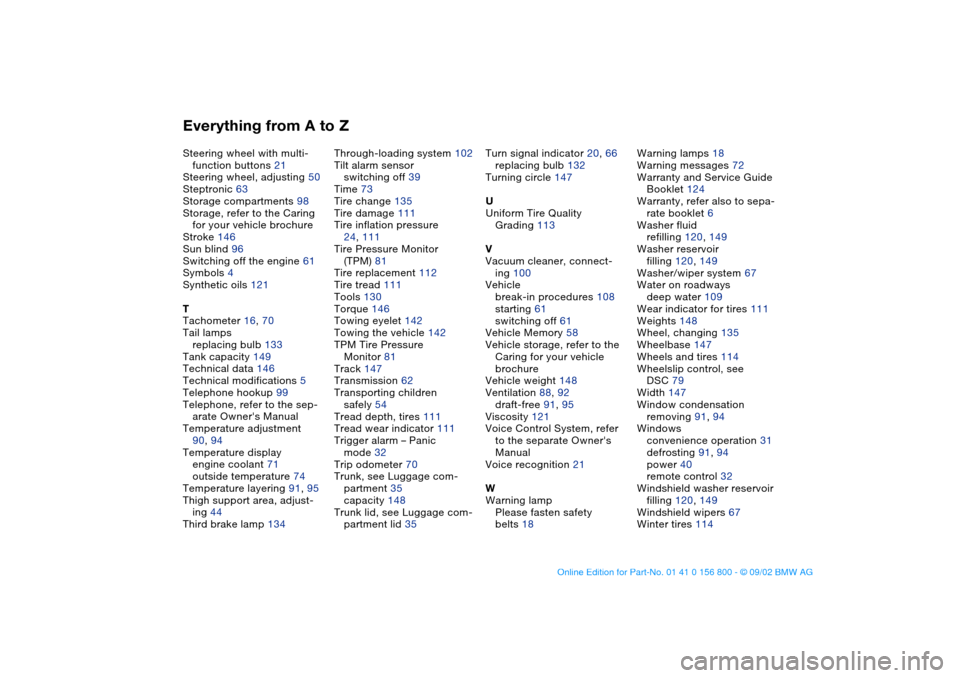Page 71 of 162

71
Fuel gaugeOnce the indicator lamp stays on con-
tinuously, there are still approx.
2 gallons/8 liters of fuel in the fuel tank.
Fuel tank capacity approx.
16.6 gallons/63 liters.
Certain operating conditions, such as
those encountered in mountainous
areas, may cause the needle to fluctu-
ate slightly.
Fill the fuel tank before it is com-
pletely empty. Driving to the last
drop of fuel can prevent the engine
from operating properly and result in
damage.<
When you switch on the ignition, the
indicator lamp lights up briefly as an
operation check.
Engine coolant temperature gaugeBlueThe engine is still cold. Drive at moder-
ate engine and vehicle speeds.RedWhen you switch on the ignition, the
warning lamp comes on briefly as an
operation check.
If the lamp comes on during normal
vehicle operation: the engine has over-
heated. Stop and switch the engine off
immediately and allow it to cool down.
To check coolant level, refer to
page 122.
Between the blue and red zonesNormal operating range. The needle
may rise as far as the edge of the red
sector during normal operation.
OverviewControlsMaintenanceRepairsDataIndex
handbook.book Page 71 Tuesday, July 30, 2002 12:16 PM
Page 153 of 162

Everything from A to Z
153
Cockpit 14
Code, refer to the Owner's
Manual for Radio
Coin box 98
Compartments 98
Compression ratio 146
Computer 74
Condensation
removing from windows
91, 94
Consumption 75
display 71
Coolant 122, 149
Cooling system 149
Copyright 4
Cornering Brake Control
(CBC) 18, 109
Cruise control 68
Cup holder, see Beverage
holder 98
Curb weight 148
Cushion height 147
D
Data
dimensions 147
engine 146
technical 146
weights 148
Daytime driving lamps 85
DBC Dynamic Brake
Control 109Defrost position 91, 94
Defrosting
rear window 90, 95
windows 91, 94
Digital clock 73
Dimensions 147
Dipstick, engine oil 120
Displacement 146
Display lighting 86
Displays 16
Distance warning 76
Divided rear backrest 102
Door key 30
Door lock buttons 34
Doors
emergency operation 33
unlocking and locking 31
Driving notes 109
DSC Dynamic Stability Con-
trol 18, 19, 79
DTC Dynamic Traction
Control 79
Dynamic Brake Control
(DBC) 109
Dynamic Stability Control
(DSC) 18, 19, 79
Dynamic Traction Control
(DTC) 79
E
Electric power windows 40Electrical accessories, fail-
ure 140
Electrical malfunction
fuel filler door 23
sliding/tilt sunroof 42
Emergency operation
doors 33
fuel filler door 23
sliding/tilt sunroof 42
Emergency release
luggage compartment
lid 37
Emissions, minimum, refer
to Energy control 70
Energy control 70
Engine
starting 59
switching off 61
Engine compartment 118
Engine coolant 149
adding 122
temperature gauge 71
Engine data 146
Engine oil
adding 120
capacity 149
quality 121
viscosity 121
Engine oil consumption 120
Engine oil level 19
check 120
Engine oil pressure 18Engine oil types 121
Engine speed 146
Entering the rear 46
Environmentally-friendly
driving, refer to Energy
control 70
Exterior mirrors 50
Eyelet, towing 142
F
False alarm, avoiding 39
Fault displays 72
First-aid kit 22
Flashlight 98
Flat tire 111, 135
Flat Tire Monitor 82
Fog lamps 87
Folding rear backrest 102
Follow me home lamps 85
Front fog lamps 87
Front seat adjustment 43
Frost protection
radiator 122
Fuel consumption 75
display 71
Fuel economy, refer to
Energy control 70
Fuel filler door 23
release following an elec-
trical malfunction 23
Fuel gauge 71
Fuel specifications 24
OverviewControlsMaintenanceRepairsDataIndex
handbook.book Page 153 Tuesday, July 30, 2002 12:16 PM
Page 156 of 162

Everything from A to ZSteering wheel with multi-
function buttons 21
Steering wheel, adjusting 50
Steptronic 63
Storage compartments 98
Storage, refer to the Caring
for your vehicle brochure
Stroke 146
Sun blind 96
Switching off the engine 61
Symbols 4
Synthetic oils 121
T
Tachometer 16, 70
Tail lamps
replacing bulb 133
Tank capacity 149
Technical data 146
Technical modifications 5
Telephone hookup 99
Telephone, refer to the sep-
arate Owner's Manual
Temperature adjustment
90, 94
Temperature display
engine coolant 71
outside temperature 74
Temperature layering 91, 95
Thigh support area, adjust-
ing 44
Third brake lamp 134Through-loading system 102
Tilt alarm sensor
switching off 39
Time 73
Tire change 135
Tire damage 111
Tire inflation pressure
24, 111
Tire Pressure Monitor
(TPM) 81
Tire replacement 112
Tire tread 111
Tools 130
Torque 146
Towing eyelet 142
Towing the vehicle 142
TPM Tire Pressure
Monitor 81
Track 147
Transmission 62
Transporting children
safely 54
Tread depth, tires 111
Tread wear indicator 111
Trigger alarm – Panic
mode 32
Trip odometer 70
Trunk, see Luggage com-
partment 35
capacity 148
Trunk lid, see Luggage com-
partment lid 35Turn signal indicator 20, 66
replacing bulb 132
Turning circle 147
U
Uniform Tire Quality
Grading 113
V
Vacuum cleaner, connect-
ing 100
Vehicle
break-in procedures 108
starting 61
switching off 61
Vehicle Memory 58
Vehicle storage, refer to the
Caring for your vehicle
brochure
Vehicle weight 148
Ventilation 88, 92
draft-free 91, 95
Viscosity 121
Voice Control System, refer
to the separate Owner's
Manual
Voice recognition 21
W
Warning lamp
Please fasten safety
belts 18Warning lamps 18
Warning messages 72
Warranty and Service Guide
Booklet 124
Warranty, refer also to sepa-
rate booklet 6
Washer fluid
refilling 120, 149
Washer reservoir
filling 120, 149
Washer/wiper system 67
Water on roadways
deep water 109
Wear indicator for tires 111
Weights 148
Wheel, changing 135
Wheelbase 147
Wheels and tires 114
Wheelslip control, see
DSC 79
Width 147
Window condensation
removing 91, 94
Windows
convenience operation 31
defrosting 91, 94
power 40
remote control 32
Windshield washer reservoir
filling 120, 149
Windshield wipers 67
Winter tires 114
handbook.book Page 156 Tuesday, July 30, 2002 12:16 PM